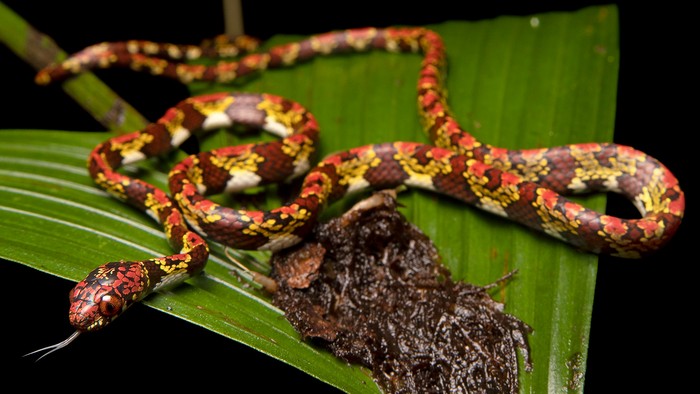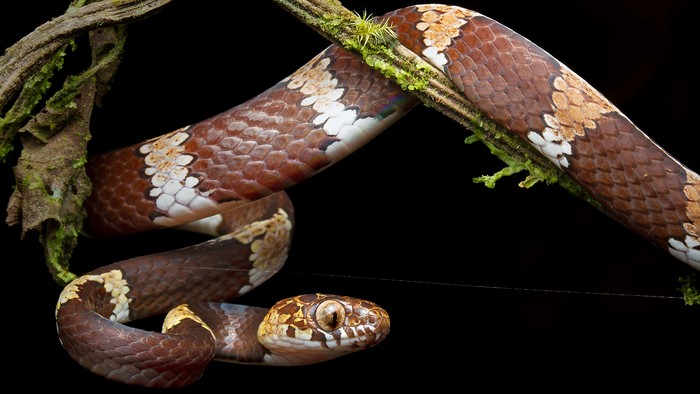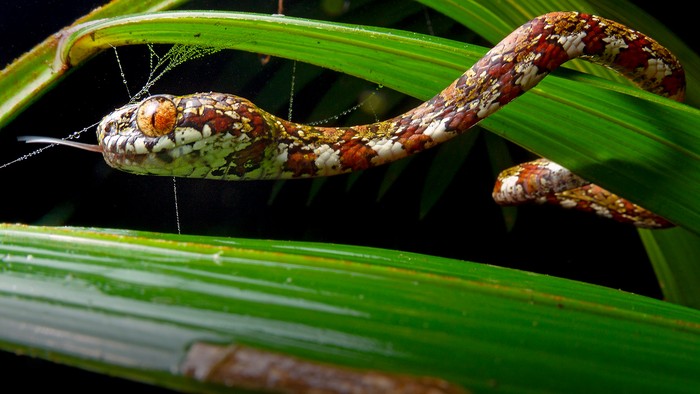'Leonardo DiCaprio' snake with bright orange eyes discovered in Panama jungle
Five species of previously unknown snakes with stunning eyes were discovered in jungle trees, and one was named after Leonardo DiCaprio. But mining threatens them all.
Slithering among shrubs in the foothill forests of Panama, there is a snake the color of burnt embers, with round eyes like glowing coals. The snake, soon to be named DiCaprio's snail-eating snake (Sibon irmelindicaprioae), is one of five newfound species living in the jungles of Central and South America. In a new study, researchers described the new species and shed light on how gold and copper mining operations in the region may threaten other stunning snakes.
"These new species of snake are just the tip of the iceberg in terms of new species discoveries in this region," lead author Alejandro Arteaga, president and research director at the Khamai Foundation, a conservation-focused nongovernmental organization, said in a statement. "But if illegal mining continues at this rate, there may not be an opportunity to make any future discoveries."
S. irmelindicaprioae derives its name from actor and conservationist Leonardo DiCaprio, who asked that the red-eyed snake be named for his mother, Irmelin Indenbirken. DiCaprio's eponymous snake is about 15 inches (38 centimeters) long, and spends its evenings on palm fronds 10 feet (3 meters) above the ground, foraging for snails and slugs. Docile to a fault, the snake defends itself not by biting but by coiling protectively around its head and emitting a foul odor.
The other four newfound species described in the study, published Jan. 25 in the journal ZooKeys, are the canopy snail-eating snake (Sibon canopy), Marley's snail-eating snake (Sibon marleyae), Vieira's snail-eating snake (Sibon vieirai), and Welborn's snail-eating snake (Dipsas welborni).




To identify the new species, Arteaga and colleagues built an evolutionary tree of Dipsadinae — a large and diverse subfamily of arboreal, terrestrial and aquatic snakes found in the Americas — after analyzing 343 sequences of snake DNA. The scientists determined that five species were sufficiently distinct from their closest relatives, in both appearance and genetics, to qualify as new species. DiCaprio's snake, for instance, does not immediately look much different from Siphonops annulatus, a fellow Dipsadine. But in addition to genetic differences, the two species have distinct coloring patterns along their backs and heads, among other telltale signs that they are not quite the same.
Unfortunately, most of these new snail-eating species face substantial challenges; the authors think that DiCaprio's snake already fits International Union for Conservation of Nature criteria for "near-threatened," as gold and copper mining operations are ravaging the rainforests the snakes call home. All five snake species are arboreal, which means they cannot survive in deforested areas, and all rely on a steady diet of slugs and snails that are in decline due to mining-related pollution in streams and rivers, according to the statement.
In Ecuador and Colombia, the challenge is largely illegal open-pit gold mines, which sprung up recently in response to a regional gold rush that has led to violence against park rangers and conservationists who stand in the way of deforestation. "When I first explored the rainforests of Nangaritza River in 2014, I remember thinking the place was an undiscovered and unspoiled paradise," Arteaga said. "In fact, the place is called Nuevo Paraíso [New Paradise] in Spanish, but it is a paradise no more. Hundreds of illegal gold miners using backhoe loaders have now taken possession of the river margins, which are now destroyed and turned into rubble."
Get the world’s most fascinating discoveries delivered straight to your inbox.
In Panama, where DiCaprio's snake lives, the problem is legal copper mining.
"Both legal and illegal open-pit mines are uninhabitable for the snail-eating snakes," Arteaga said, "but the legal mines may be the lesser of two evils. At the very least they respect the limit of nearby protected areas, answer to a higher authority, and are presumably unlikely to enact violence on park rangers, researchers, and conservationists."

Joshua A. Krisch is a freelance science writer. He is particularly interested in biology and biomedical sciences, but he has covered technology, environmental issues, space, mathematics, and health policy, and he is interested in anything that could plausibly be defined as science. Joshua studied biology at Yeshiva University, and later completed graduate work in health sciences at Cornell University and science journalism at New York University.
 Live Science Plus
Live Science Plus







